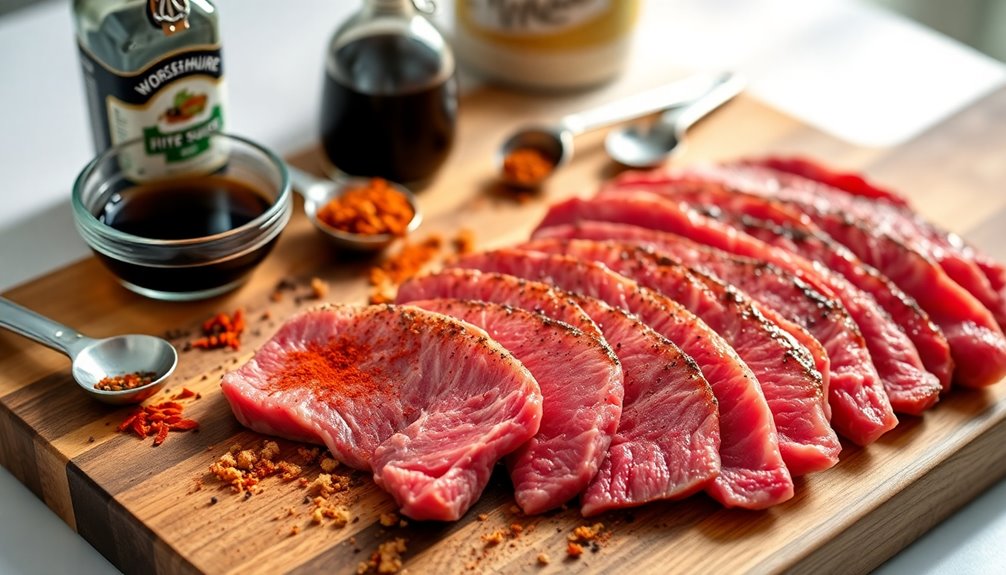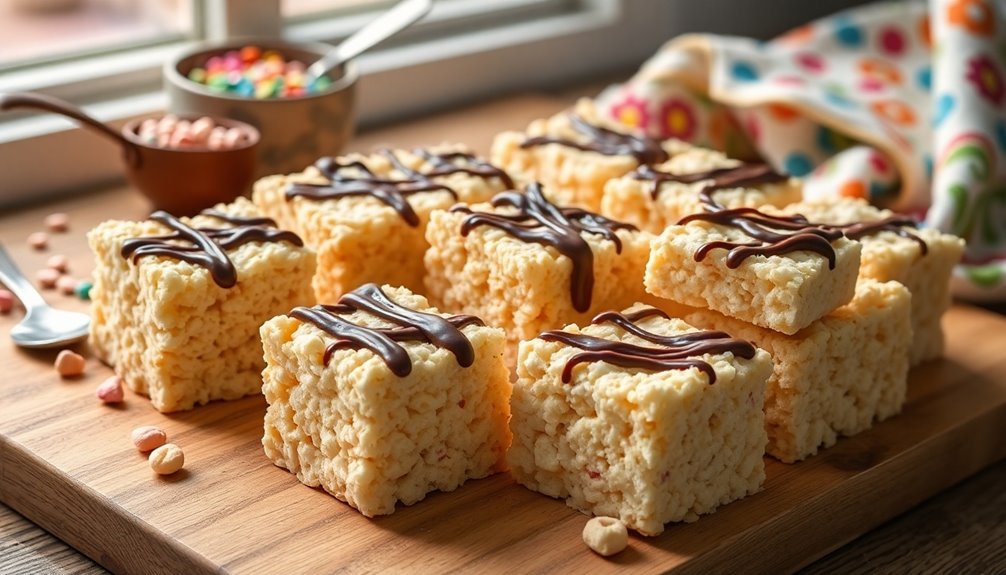You can make your own delicious beef jerky at home with just a few ingredients. Start with lean cuts like flank or sirloin. Trim excess fat, then slice the beef against the grain. Marinate it in a mix of soy sauce and your favorite spices for at least four hours. Pat it dry before dehydrating at 160°F for 4-6 hours until it's firm but pliable. Once cooled, store your jerky in airtight containers to keep it fresh. It's a simple yet satisfying snack packed with protein. Keep going to discover more tips and tricks for perfecting your jerky!
Key Takeaways
- Choose lean cuts of beef, such as flank steak or sirloin, and slice against the grain for tenderness.
- Marinate the beef for at least 4 hours or overnight using soy sauce, Worcestershire sauce, and spices.
- Pat the marinated beef dry to remove excess moisture before drying it.
- Dehydrate the beef at 160°F for 4-6 hours, ensuring it is firm but pliable.
- Store the finished jerky in airtight containers or vacuum-sealed bags to maintain freshness and prevent spoilage.
History

Beef jerky has a rich history that dates back centuries, originating as a method to preserve meat in ancient cultures.
You might find it fascinating that Native Americans and early explorers used this technique to guarantee they'd sustenance during long journeys. They'd dry strips of meat in the sun or over a fire, allowing it to last without refrigeration. This preservation method was essential for survival, especially in harsh environments.
As the years went by, beef jerky evolved, becoming a popular snack for cowboys and soldiers alike.
Today, you enjoy various flavors and styles, but at its core, beef jerky remains a reflection of ingenuity, turning simple meat into a long-lasting, portable source of nourishment.
Recipe

Making beef jerky at home is a rewarding experience that allows you to customize flavors and create a delicious, protein-packed snack. This simple recipe involves marinating strips of beef in a flavorful mixture before drying them out to achieve that iconic jerky texture. Whether you enjoy it as a hiking snack, a game-day treat, or just a quick bite, homemade beef jerky can be tailored to suit your taste preferences.
Before you immerse yourself in the cooking process, it's important to select the right cut of beef. Flank steak, sirloin, or round steak are excellent choices due to their low-fat content, which helps in the drying process. The key to achieving a great jerky lies in the marinade and the drying method, which can be done using a dehydrator, an oven, or even a smoker. With a bit of preparation, you can enjoy flavorful, homemade beef jerky in just a few hours.
Ingredients:
- 2 pounds of flank steak or sirloin
- 1/2 cup soy sauce
- 1/4 cup Worcestershire sauce
- 1/4 cup brown sugar
- 1 tablespoon smoked paprika
- 1 teaspoon garlic powder
- 1 teaspoon onion powder
- 1 teaspoon black pepper
- 1/2 teaspoon red pepper flakes (optional)
- 1 teaspoon liquid smoke (optional)
To prepare the beef jerky, start by slicing the beef against the grain into thin strips, approximately 1/8 to 1/4 inch thick. In a bowl, combine soy sauce, Worcestershire sauce, brown sugar, smoked paprika, garlic powder, onion powder, black pepper, red pepper flakes, and liquid smoke if using.
Mix well and add the sliced beef to the marinade, ensuring all pieces are coated. Cover the bowl and refrigerate for at least 4 hours, or ideally overnight for maximum flavor. After marinating, remove the beef strips and pat them dry with paper towels.
Preheat your dehydrator to 160°F, or if using an oven, preheat to the lowest setting. Arrange the beef strips in a single layer on the dehydrator trays or a baking sheet lined with parchment paper. Dehydrate for 4-6 hours, checking for doneness; the jerky should be dry but still slightly pliable.
When making beef jerky, remember that the thickness of your slices can greatly affect the drying time, so try to keep them uniform. If you're using an oven, prop the door open slightly with a wooden spoon to allow moisture to escape.
For added flavor, feel free to experiment with different spices and marinades, such as teriyaki or spicy chipotle. Once your jerky is finished, store it in an airtight container or vacuum-sealed bag to maintain freshness. Enjoy your homemade creation!
Cooking Steps

Now that you've got your ingredients ready, it's time to start the cooking process.
First, you'll slice the beef into strips and marinate them for 12 hours to absorb all the flavors.
After that, you'll dehydrate the beef at 160°F and season it with your favorite spices for that perfect kick.
Step 1. Slice Beef Into Strips

To create delicious beef jerky, you'll want to slice your meat into thin, uniform strips. Start by choosing a lean cut of beef, like top round or flank steak, as it'll yield the best results.
Freeze the meat for about an hour; this will make slicing easier. Once firm, use a sharp knife to cut against the grain, aiming for strips about 1/8 to 1/4 inch thick. Consistency in thickness is key to guarantee even drying during the jerky-making process.
If you prefer thicker pieces, adjust your drying time accordingly. Place the slices on a cutting board, and make sure to remove any excess fat, as this can lead to spoilage.
With your strips ready, you're one step closer to homemade jerky!
Step 2. Marinate for 12 Hours

After slicing your beef, marinating it for 12 hours will infuse incredible flavor into your jerky. This step is essential for achieving that rich, savory taste you're aiming for.
Start by placing the beef strips in a large resealable bag or a shallow dish. Pour your marinade over the beef, making sure it's well-coated. Seal the bag tightly or cover the dish, and then refrigerate it.
The longer the beef sits in the marinade, the more flavor it absorbs, so try to resist the urge to rush this process. If you can, flip the bag or stir the beef halfway through to guarantee even coverage.
After 12 hours, you'll be ready to move on to the next step in your jerky-making journey.
Step 3. Dehydrate at 160°F

Once your beef has marinated for the full 12 hours, it's time to dehydrate it at 160°F.
Preheat your dehydrator or oven to the desired temperature. Lay the marinated beef strips in a single layer on the dehydrator trays or a baking sheet, ensuring they don't overlap. This helps them dry evenly.
If you're using an oven, prop the door open slightly to allow moisture to escape. Dehydrate the beef for about 4 to 6 hours, checking occasionally for doneness. You'll know it's ready when the jerky is dry but still slightly pliable.
Once done, let it cool before storing it in an airtight container. Enjoy your homemade beef jerky!
Step 4. Season With Spices

How can you elevate the flavor of your beef jerky? Start by choosing your favorite spices and seasonings. A classic blend includes garlic powder, onion powder, and black pepper, but feel free to experiment!
Add a pinch of cayenne for heat or smoked paprika for a smoky flavor. Don't forget to incorporate a bit of sugar to balance the savory elements. Additionally, using a diversification strategy in your seasoning choices can lead to a more complex flavor profile.
After mixing your spices, rub them evenly over the beef strips. Make sure every piece is coated well for consistent flavor. Including a variety of spices can also contribute to increased metabolism, which is beneficial for overall health.
Allow the seasoned meat to marinate for at least four hours, or overnight if you can. This marinating step infuses the jerky with rich flavors that will enhance your snacking experience. Additionally, consider the importance of ethical implications when using automated processes for food production, as they can impact quality and safety.
Now, you're ready to dehydrate!
Step 5. Store in Airtight Container

To guarantee your beef jerky stays fresh and flavorful, store it in an airtight container as soon as it cools down. This step is essential for preventing moisture from sneaking in, which can lead to spoilage.
Choose a container that seals tightly; glass jars or vacuum-sealed bags work well. If you plan to keep your jerky for an extended period, consider freezing it in a vacuum-sealed bag to maintain its quality.
Always label your container with the date you made the jerky, so you can keep track of its freshness. When you're ready to enjoy a piece, just grab what you need and reseal the container quickly to keep the rest protected.
Enjoy your homemade jerky!
Final Thoughts

As you reflect on your journey to making beef jerky, it's clear that the process is as rewarding as the delicious result.
You've crafted a tasty snack that not only satisfies your cravings but also showcases your culinary skills. Whether you've experimented with different marinades or perfected your drying technique, you've gained valuable knowledge along the way.
Don't forget to share your homemade jerky with friends and family; they'll appreciate the effort you put into it.
Plus, experimenting with flavors can lead to even more unique creations.
Finally, enjoy the satisfaction of knowing you've made something wholesome and preservative-free.
Frequently Asked Questions
What Type of Meat Is Best for Jerky?
When you're choosing meat for jerky, lean cuts work best.
Look for options like top round, bottom round, or eye of round beef, as they've less fat. If you prefer something different, turkey and venison also make excellent choices.
These meats dry well and absorb flavors effectively. Remember to trim any visible fat, as it can spoil and affect the jerky's shelf life.
How Long Does Homemade Beef Jerky Last?
Homemade beef jerky can last quite a while if you store it properly.
Generally, it'll stay good for about 1 to 2 months at room temperature in an airtight container.
If you refrigerate it, you can extend its shelf life to around 3 to 6 months.
For even longer storage, consider freezing it, where it can last up to a year.
Just make sure it's sealed well to prevent freezer burn!
Can I Use a Dehydrator Instead of an Oven?
Absolutely, you can use a dehydrator instead of an oven!
Dehydrators are designed specifically for drying out foods, making them ideal for achieving that perfect jerky texture. They often have adjustable temperature settings and better air circulation, ensuring even drying.
Just follow the manufacturer's instructions for time and temperature, and you'll get delicious results.
Plus, using a dehydrator can save energy compared to running your oven for hours!
Is It Safe to Make Jerky at Home?
Yes, it's safe to make jerky at home if you follow proper guidelines.
Start with high-quality meat, and guarantee you marinate it in a solution that includes salt, which helps preserve it.
Use a dehydrator or oven set at the right temperature to kill harmful bacteria.
Make sure to store your jerky in airtight containers to prevent spoilage.
If you keep these precautions in mind, you can enjoy your homemade jerky safely.
How Can I Adjust the Flavor of My Jerky?
To adjust the flavor of your jerky, start by experimenting with marinades. You can mix soy sauce, Worcestershire sauce, and your favorite spices to create a unique taste.
Try adding garlic powder, onion powder, or even a touch of brown sugar for sweetness. Don't forget to taste your marinade before applying it; it'll give you a good idea of the final flavor.
After marinating, let it sit for a while to absorb those flavors!










